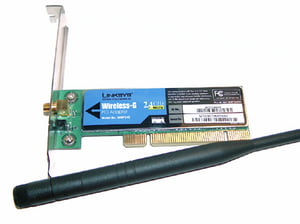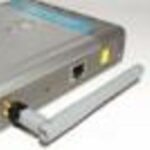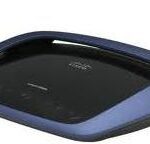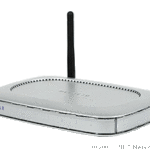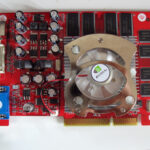Wireless networking has become extremely popular in the past few years, due to falling prices, faster speeds, and rising throughput rates. Currently, the most commonly available wireless products use the wireless 802.11g 2.4GHz standard, which allows very fast connections of up to 54Mbs.
For this review, I decided to cut the (LAN) cable and test two 802.11g wireless PCI cards: the Belkin F5D7000 Wireless G Desktop Card ($49.99 at newegg.com) and the Linksys WMP54 Wireless-G PCI Adapter ($56.00 at newegg.com). I scored the cards on (1) Installation, (2) Software, Drivers, and Configuration, (3) Range, and (4) Security.
Test System Configuration
I tested each card on two different computer systems, each with different hardware configurations and operating systems, using my existing wireless network.
Belkin Card Test Systems:
Alienware Aurora
CPU: AMD Athlon 1600+
RAM: 1GB
Operating System: Dual-Boot Windows XP Home sp2/Ubuntu Linux v7.04
HP Pavilion 6400Z
CPU: Intel P2 400MHz
RAM: 256
Operating System: Windows 2000 sp4
Linksys Card Test Systems:
Self-Built PC
CPU: Intel P4 2.4GHz
RAM: 1GB
Operating System: Windows XP Pro sp2
Alienware Aurora
CPU: AMD Athlon64 4000+
RAM: 2GB
Operating System: Windows XP Home sp2
Wireless Network/Internet Connection
I used my existing Apple Airport wireless 802.11 network, which consists of one Airport Extreme base station and one Airport Express used as a range extender. The wireless network connects to the internet using my 1.5Mbs cable broadband connection.
1. Installation
Installation of both the Belkin and Linksys cards was a snap, in all of the computer systems. In every system all I had to do was (1) open the side of the computer case, (2) unscrew and remove the PCI slot cover, (3) push the PCI card firmly into the slot, (4) secure the card with the screw from the slot cover, (5) close the case back up, and (6) screw the little antenna onto the nub on the back of the newly installed card. I did have some trouble getting the Linksys card into the Athlon64 Alienware, because the CPU cooling fan shield is the approximately the size (and shape) of the Pepsi Center. Luckily, I have small hands.
Winner: Tie
2. Software, Drivers, and Configuration
Both cards came with a Compact Disc containing Windows-only configuration software, Windows drivers, and a user’s manual.
Belkin Software and Drivers in Windows
The software and drivers on the Belkin CD were very easy to install in Windows on both the Athlon 1600+ system and the HP system. I was very impressed with the fact that my 10-year-old HP computer was able to run the Belkin software without a hiccup or hitch, even with its limited RAM capacity. The software is designed to walk you through the configuration process, and does so quite well-if your network setup is very simple.
Unfortunately, I had serious difficulties getting the software to work properly with my network setup. The software seems to force the adapter to latch onto the nearest access point on the network, whether or not it actually provides the strongest signal, and to add insult to injury does not provide a way to select a specific access point by MAC address or any other means. As a result, I was consistently getting a poor quality connection with very low or dropped signal. I tried going around the configuration software using the Windows Wireless Connection tool, with no success. I was unable to get a consistent connection until I moved my Airport Express network range extender into the same room as the computers.
Belkin Drivers in Ubuntu Linux
Many manufacturers have created or allowed the open source community to create Linux drivers for their products, but unfortunately Belkin isn’t one of them. Because of this, a workaround using the Windows driver and the ndiswrapper package had to be installed manually, a task that ended up taking the better part of an hour, since I didn’t have a working internet connection on that computer yet. However, once the driver was installed, I simply could not get the Network tool to connect to my wireless network. Ubuntu could see both the wireless network and the Belkin card but couldn’t connect the two even when I experimentally turned off the WEP encryption. I also tried to connect using the Terminal, with no success.
Linksys Software and Drivers in Windows
The software and drivers on the Linksys CD installed easily on both the Self-Built and Athlon64 systems. The software is easy to use, and makes the configuration process quite simple. I was very impressed with the way Linksys handles multiple networks and access points. One click, and I had selected my wireless network, and two clicks and a password entry later I had selected the specific access point (by MAC address) that I wanted the adapter to use. A couple clicks more, and it was configured and online.
Linksys Drivers in Ubuntu Linux
Linksys has allowed the open source community to create drivers for their products, and according to the Ubuntu Linux web site, Ubuntu provides plug-n-play support for most Linksys products. I did not have time to test this card in Ubuntu, but since I have had absolutely no problems using a Linksys USB Wireless-G adapter in Ubuntu, I expect it to work fine.
Winner: Linksys
3. Range
Both cards were tested within10-20 feet of my main wireless network access point. The Belkin card claims 400 feet of wireless coverage, but the Linksys makes no range claims. However, the Linksys card consistently provided a higher quality connection during testing. I believe this difference was due primarily to the difficulty with access point selection I mentioned previously. When the cards were utilizing the same access point, there was little difference in the connection quality.
Winner: Linksys
4. Security
The Linksys adapter allows use of either WEP or the more secure WPA encryption. The Belkin card allows only WEP encryption.
Winner: Linksys
Overall Impression
The Linksys WMP54 Wireless-G PCI Adapter is the clear winner. The ease of configuration, range, and cross-platform utility of this product made it an easy choice. To be fair, if I was using a Windows-only network with only one access point, the Belkin F5D7000 Wireless G Desktop Card would probably be acceptable. However, since the price difference between the two is a mere $5, I would recommend purchasing the better choice: The Linksys WMP54 Wireless-G PCI Adapter.
